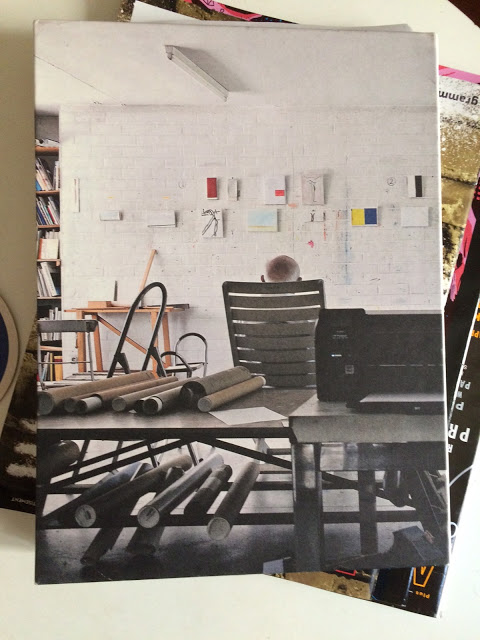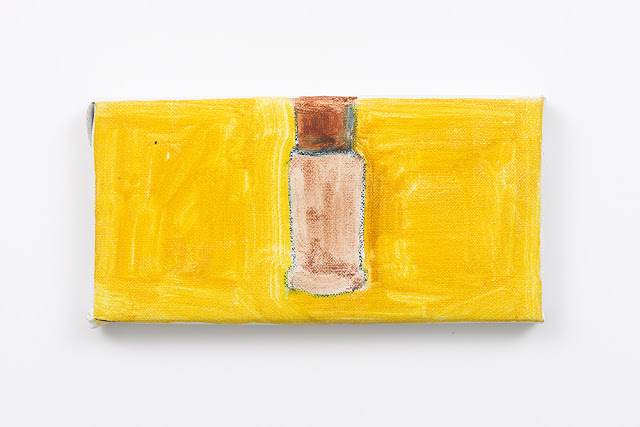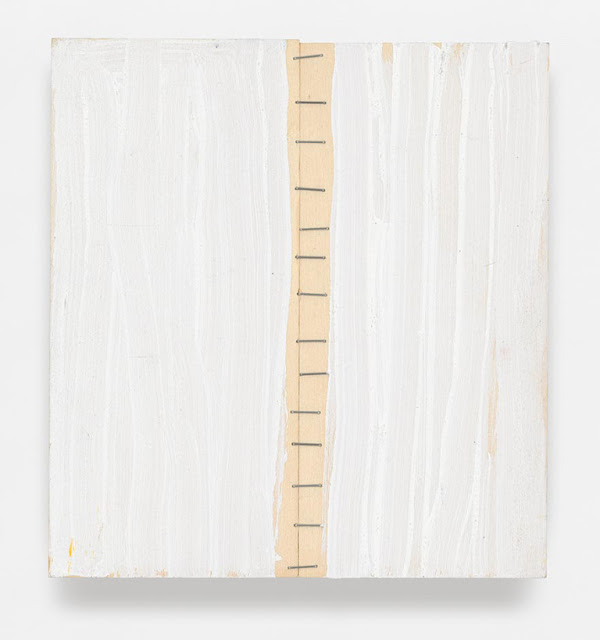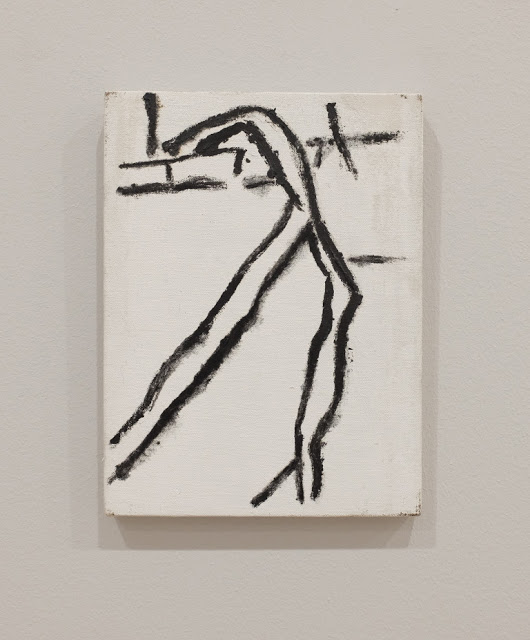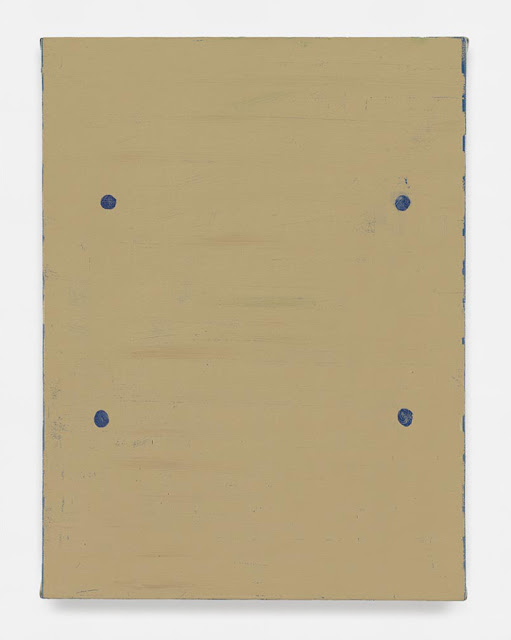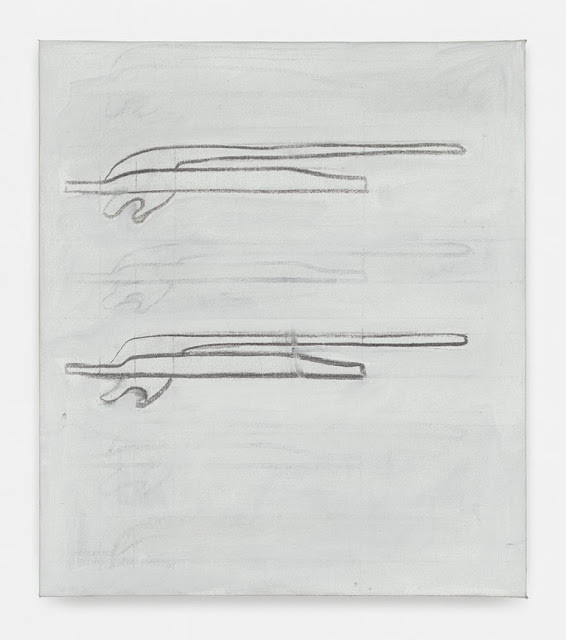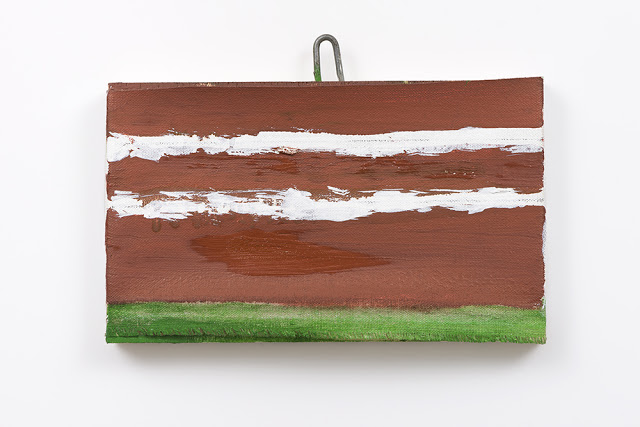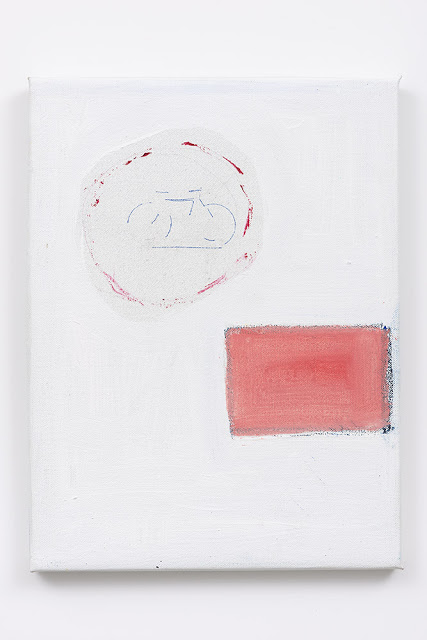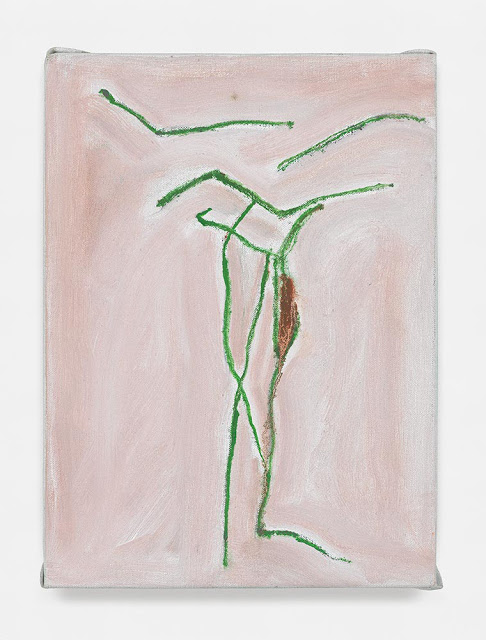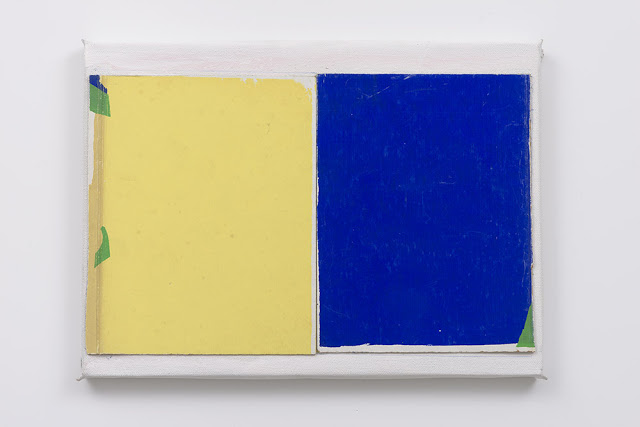“Drift,” the sublime Raoul De Keyser exhibition on view at David Zwirner through April 23, was organized around a group of 22 small paintings known as The Last Wall. Completed shortly before his death in October 2012, they are hung in the gallery exactly as De Keyser had installed them on the wall of his Deinze, Belgium, studio. The title, coined posthumously for a 2014 book about the series [Jef Van Eynde, Raoul De Keyser: The Last Wall (Ghent: MER. Paper Kunsthalle, 2014)], is a poignant reminder that studio practice for each of us will eventually end. Curator Ulrich Loock wrote an excellent essay for the beautiful catalogue, published by David Zwirner Books, about the relationship of these final paintings to the rest of De Keyser’s work, and I am delighted to publish an excerpt:
The paintings of The Last Wall relate to the artist�s earlier
work like a code. They depend on it, without, conversely, implying that
the code could be used to reconstruct the oeuvre. The underlying work is
displaced by the return; the repetition falls wide of any origin. This
kind of productive dependence on earlier works is not just a feature of
De Keyser�s last paintings; it runs throughout his entire oeuvre. In a
wide-ranging essay on the various periods of the artist�s practice, Steven Jacobs has
shown that De Keyser was already layering different coats of paint on
top of each other in his early works, that he later reproduced his own
images and integrated them into new works, and that he often painted
over finished pieces. [1] For instance, there are two monochromatic
works�one blue, one red�that were originally olive-green paintings with
white lines from 1971 and 1973, which De Keyser then covered with new
solid coats of color in 1982 (Untitled ; ill. pp. 17�21). The
lines came from the white markings of a soccer field that was often a
source for his paintings after 1970….
De Keyser connects his works to a model, a reference point, a motivation, thus highlighting earlier works, perhaps even critically. But while the paintings are distinguished by a moment of mnemonic recurrence, the referentiality remains strangely inconclusive, since one cannot tell what the model (in this case the linocut) refers to. Because it isn�t clear why the original object was painted�possibilities include the linocut�s relationship to a specific set of circumstances, a moment of emotional engagement on the part of the artist, or an interest in a particular formal arrangement, among many other things�one is left with the general observation that there is a referential relationship of some kind to the artist�s own work. Then attention returns, as if by itself, unbidden, to a colorful picture plane in which oddly shaped figures are embedded like intarsias. A circularity and interdependence runs throughout moments that would seem to be mutually exclusive�the painting�s referentiality and its self-contained presence.
It is tempting but not unproblematic to clarify the ambiguity of De Keyser�s painting with the concept of �homeless representation,� [2] coined by Clement Greenberg in 1962. Greenberg used the term to denote �a plastic and descriptive painterliness that is applied to abstract ends, but which continues to suggest representational ones.� [3] In the case of De Keyser, the autonomy of painting is not an overarching, ultimate goal to be reached by a detour through its opposite. Rather, by referring to other images, De Keyser succeeds in creating a situation in which his painting is kept free from pure subjective construction and is able, through mimesis, to acknowledge a reality outside itself. At the same time, however, autonomy of construction is necessary so that painting does not become a means to an end and lose itself to what it is not. Painting cannot affirm the autonomy of things if it does not possess that autonomy itself. Since in certain cases the objects depicted are his own past images, De Keyser arrives at paintings that have no objective outside themselves. Through a particular kind of self-referentiality, he manages to balance depiction and the autonomy of the image, avoiding a compromise between the two.
It is precisely the carefully orchestrated self-referentiality of De Keyser�s paintings that, as [Paul Robbrecht observes in �Paintings Temporarily Leaning Against a Wall,�], keeps them from becoming attached to the place where they are exhibited. This connects them to the work of artists who emerged in the 1980s and are associated with the concept of atopia�from Jan Vercruysse to Ren� Dani�ls, from Jean-Marc Bustamante to Reinhard Mucha or Harald Klingelh�ller. One might argue that the atopian construction of the work of these and some other artists is a conscious response to the loss of certainty regarding the place of the artwork in the modern era.
Regardless of the individual styles of The Last Wall�s paintings�mimetic renderings or self-contained constructions�all refer to models from the artist�s previous work, call those templates to mind, and recapitulate them in reinvigorated forms. The return enacted by the paintings of The Last Wall with a very limited set of painterly tools and techniques is both serious and deeply whimsical. It seals an oeuvre marked by De Keyser�s particular attitude. In many things he did, not just as a painter but in his everyday life, he took specific steps to create a dependence on impulses he did not fully control. In addition to his recourse to earlier paintings, a number of his works point to distinct moments or spaces that informed them. This can be seen in titles (e.g., Bern-Berlin hangend, 1993, ill. p. 41, a reference to two exhibition venues that were especially important to De Keyser at the time, or Dalton, 1990, ill. p. 27, a reference to the four Daltons from the Lucky Luke comics) and subject matter (e.g., his studio�s surroundings that include the monkey puzzle tree outside of the window in the aforementioned Bern-Berlin hangend; the folding grille, Closerie I (Berliner Ensemble), 1998, ill. p. 45 ; or the internal staircase, Untitled, 1998, ill. p. 49). Other works include features that make the image look accidental�like the result of a malfunction, an encounter, an incident, or an experiment�as in the case of traces left by a tube of paint that De Keyser threw at some of his paintings, or a final brushstroke that looks like the letter Z (Z, 1990 ; ill. p. 29). For De Keyser, what is central is not the ideal of the self-contained work. Rather, the paintings create mimetic connections to things outside themselves or incorporate the traces of passing circumstances. But to do justice to the independence of external reality, referentiality is turned into a mode of construction that acts as if nothing existed outside the paintings themselves.
As varied as his paintings became over the decades, and as great as the differences are among the images of The Last Wall, De Keyser actually referred only to a fairly small number of things. In addition to his own previous works, they are mostly things that possess an inherent affinity with painting, in which painting can recognize itself. Their particular paintability is confirmed by De Keyser�s familiarity with them. If, after 1970, De Keyser repeatedly painted the white markings of the soccer field opposite his house�even the horizontal rectangle of Flooded in Brown (2012 ; ill. p. 127), a work from The Last Wall, can be traced to the lines he first painted forty years earlier�this reflects more than his enthusiasm for the sport. He was also painting a field with lines that echoed the picture plane and could be incorporated into his work without the kind of painterly manipulation that is coded as illusionism or abstraction. [4] The situation was similar with the bank of the nearby Leie River, in which De Keyser swam and canoed. The layers of water, land, and sky that rose up before him were marked by horizontal lines, and they were oriented in the same way as the painting on the wall. Jacobs makes a similar argument with regard to De Keyser�s painting of a window of his house; when he painted the window, he represented the painting itself, which can be metaphorically seen as a window: �The metaphor turns into metonymy : instead of a view through to another world, the window draws the viewer�s attention to the color, the paint, and the support.� [5]
Raoul De Keyser, Blue R, 2012, gesso and silkscreen on cardboard on canvas mounted on wood panel
[Image at top: This is a snap of the moving photo on the back cover of the catalogue. Raoul De Keyser sits, looking at the paintings of The Last Wall, as he installed them in his studio in 2012. Photo by Jef Van Eynde.]
References
[1] See Steven Jacobs, Raoul De Keyser: Retour 1964�2006 (Ghent: Ludion, 2007). This publication�s text is a revised and expanded version of Jacobs�s essay, �What Remains of Depth Is Enveloped in Colour. Raoul De Keyser�s Painting 1964�2000,� in Steven Jacobs, ed., Raoul De Keyser: Paintings 1980�1999 (Ghent and Amsterdam: Ludion, 2000).
[2] See Jacobs, Raoul De Keyser: Retour 1964�2006, p. 59 and Robert Storr, �On Knowing One�s Place,� in Raoul De Keyser. Terminus: Drawings (1979�1982) and Recent Paintings. Exh. cat. (New York and G�ttingen: David Zwirner and Steidl, 2011), n.p.
[3] Clement Greenberg, �After Abstract Expressionism,� in John O�Brian, ed., The Collected Essays and Criticism, Volume 4: Modernism with a Vengeance 1957�1969 (Chicago and London: The University of Chicago Press, 1993), p. 124.
[4] See Roland Jooris, �Precipitations : Excerpts on De Keyser�s Work from My Artists� Logbook,� in Raoul De Keyser: Paintings 1980�1999, pp. 78�83. First published as �Uit mijn plastisch logboek bij het werk van Raoul De Keyser,� in Raoul De Keyser 1979�1985 (Brussels: Museumfonds van het Ministerie van de Vlaamse Gemeenschap, 1986), pp. 7�11.
[5] Jacobs, Raoul De Keyser: Retour 1964�2006, p. 11.
“Raoul De Keyser: Drift,” curated by Ulrich Loock. David Zwirner, Chelsea, New York, NY. Through April 23, 2016.
Related posts:
Influential painter Raoul De Keyser is dead at 82
EMAIL: Rebecca Morris writes regarding Raoul De Keyser
The Casualist tendency
——
Two Coats of Paint is licensed under a Creative Commons Attribution – Noncommercial-No Derivative Works 3.0 United States License. To use content beyond the scope of this license, permission is required.

